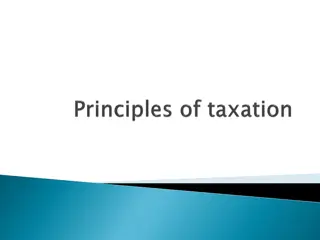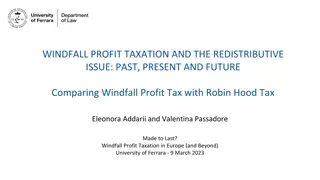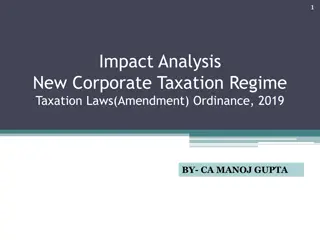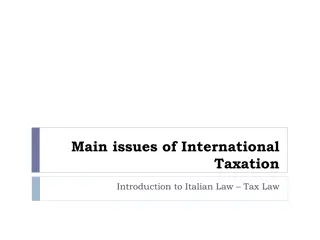State Taxation of Partnerships - Issues and Implications
The project work group outlines a comprehensive approach to addressing various issues related to state taxation of partnerships. Key topics include operating income, nexus, federal conformity, sale of partnership interests, administrative and enforcement issues, and conformity implications for multistate income. Methods for addressing these issues, including situs-based, apportionment-based, and tiered entity approaches, are discussed. Updates to the outline cover constitutional principles, formulary apportionment, UDITPA application, model regulations, and more.
Download Presentation

Please find below an Image/Link to download the presentation.
The content on the website is provided AS IS for your information and personal use only. It may not be sold, licensed, or shared on other websites without obtaining consent from the author.If you encounter any issues during the download, it is possible that the publisher has removed the file from their server.
You are allowed to download the files provided on this website for personal or commercial use, subject to the condition that they are used lawfully. All files are the property of their respective owners.
The content on the website is provided AS IS for your information and personal use only. It may not be sold, licensed, or shared on other websites without obtaining consent from the author.
E N D
Presentation Transcript
State Taxation of Partnerships September 14, 2021
The project work group has outlined a general approach to the project: 1. Identify and generally describe a comprehensive list of potential issues. Note the important relationships between those issues. Select a particular issue and develop generally recommended practices or positions. Repeat step 3 until all major issues have been addressed and reconcile any differences. Agree on overall set of recommended practices/ positions for all issues. Begin creating draft models, etc., to carry out the recommended practices/positions. 2. 3. Project Plan 4. 5. 6.
ISSUE OUTLINE General Approach Terms Operating Income - Nexus & Federal Conformity ISSUE OUTLINE Operating Income Sourcing cont d & Credits ISSUE OUTLINE Sale of Partnership Interest Sourcing & Credits Roadmap 28 Sep. 12 Oct. 31 Aug. 14 Sep. 26 Oct. 17 Aug. ISSUE OUTLINE Operating Income - Federal Conformity cont d & Sourcing ISSUE OUTLINE Sale of Partnership Interest Nexus & Conformity ISSUE OUTLINE Administrative & Enforcement
Conformity Issues Implications of conformity to Subchapter K for state tax on multistate income: Special allocations Guaranteed payments Contributed built-in gain property Inter-partnership transactions Anti-abuse rules Sourcing Different methods Example showing how different results can be Last Call
Methods: Situs Based Using partnership information (example domicile) Using partner information (example residence) Apportionment Based Using partnership factors Using partner factors (corporate partners) Using combination of factors (corporate partners) Tiered Entities Apportion using recognizing partnership factors sourcing flows through Apportion using the K-1 partnership factors Using a combination of factors Last Call
Updates To Last Version of Outline Sourcing Constitutional Principles Sourcing of Multistate Income Generally Applied to Formulary Apportionment Specifically Applying the Principles Use of UDITPA (and Similar Corporate Apportionment Rules) Model Regulations Model Combined Reporting Statutes Aggregate vs. Entity Theories Differences in Partners
States may use formulary apportionment rather than specific geographic attribution of income and expense. The factors used to apportion the income have to be fairly related to the income. Unitary business (entity unity) or operational relationship (asset unity) may connect the factors to the income being apportioned. One taxpayer may have separate unitary businesses each of which can be separately apportioned using related factors. The method must be internally and externally consistent. The standard for formulary apportionment is out of all proportion. Constitutional Principles:
Constitutional cases generally involve applying the apportionment factors of a taxable entity (or group) to income from a particular source. Constitutional Principles: In the case of partnerships the factors applied are often the factors of the source entity itself, rather than the taxpayer. Extrapolating from Entity Taxation to Passthrough Taxation This method, sometimes referred to as investee apportionment or flow-through sourcing has never been explicitly approved by the U.S. Supreme Court. (See MeadWestvaco Corp. v. Illinois Dept. of Revenue, 553 U.S. 16 (2008)).
Sourcing Questions and Issues Applying the principles to: Partnership Attributes Types of Income Nature of the Partnership Investment Operating Business/Nonbusiness Determination Corporate vs. Individual Partners Nature of the Partners Roles Distributive Share Generally Special Allocations Guaranteed Payments Built-in Gain (Loss) on Contributed Property
Example Question on Guaranteed Payments: A and B form a partnership AB. A lives in State 1, B lives in state 2. Both State 1 and State 2 use single sales factor apportionment. AB has 90% of its sales in state 2. In addition to its share of partnership items, A receives a guaranteed payment for services done for the partnership entirely in State 1. Under IRC 707(c), this guaranteed payment would reduce partnership income as an expense so that it affects A and B s distributive share of that income. Question how should the guaranteed payment be sourced?
Possible Answers: The guaranteed payment could be sourced as wages so that all of it would be sourced to State 1. The guaranteed payment could be sourced based on where the services are performed (generally) so, again, all of it would be sourced to State 1. The guaranteed payment could be apportioned in the same manner as the distributive share of partnership income so 90% would be sourced to State 2. (Would it change your answer if State 1 had no income tax?)
Variation Question on IRC 707(a) Transactions: Same facts except that A loans AB money and will be paid interest on that loan. Assuming the interest would generally be sourced to State 2 under its sales factor apportionment formula, the interest might be sourced 100% to State 2. Alternatively, the interest might be sourced in the same manner as A s distributive share 90% to State 2.
Variation Question on Built-In Gain Asset Contributed Same facts except that A contributes an asset to AB that has a built-in gain. (The asset was in State 1 but physically moved to State 2.) The asset is subsequently sold triggering the gain. Under Subchapter K, the portion of the realized gain representing built-in gain is allocated back to A. The gain could be allocated 100% to State 1. The gain could be apportioned along with A s distributive share income 90% to State 2.
Example: Role/Status of the Partner A, B, and C form a partnership ABC. ABC operates in State 1. A and B are residents of State 1. C is a resident of State 2. Is C required to source distributive share income to State 1? If C is a minority partner? If C is a limited partner? If C s role is purely passive? Does it matter whether C is a corporation of individual?
Next Steps Survey of how states have addressed important issues. Examples: Specific rules for partnership apportionment (states generally refer to corporate rules) Exceptions if any for roles/status of partners (minority of states make exceptions) Rules for guaranteed payments (a handful of states have them) Specific definitions of investment partnerships (less than half the states have them) Specific rules for determining business/nonbusiness income (differences in the rules) Consistency (or not) in state rules. Example: The minority of states have addressed guaranteed payments are split.
Next Steps We will continue to flesh out the outline and identify questions and issues. Send anything you think we should include or anything we ve missed and we ll incorporate it. Next meeting: Finish sourcing of operating income. Discuss credits for taxes paid (residents). Kick off sourcing of sale of partnership interest.
Final Note When we did our initial survey of the partnership work group we asked whether their agency could benefit from training on partnership issues 100% of the respondents said yes. Will be following up on training as we get closer to the uniformity committee meeting.























